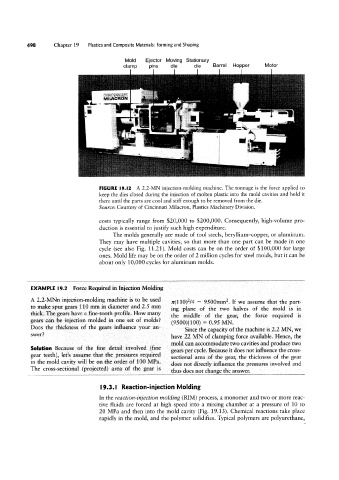Page 518 - 04. Subyek Engineering Materials - Manufacturing, Engineering and Technology SI 6th Edition - Serope Kalpakjian, Stephen Schmid (2009)
P. 518
498 Chapter 19 Plastics and Composite Materials: Forming and Shaping
Mold Ejector Moving Stationary
Clamp pins die die Barrel Hopper Motor
I I I I I
FIGURE I9.I2 A 2.2-MN injection-molding machine. The tonnage is the force applied to
keep the dies closed during the injection of molten plastic into the mold cavities and hold it
there until the parts are cool and stiff enough to be removed from the die.
Source: Courtesy of Cincinnati Milacron, Plastics Machinery Division.
costs typically range from $20,000 to $200,000. Consequently, high-volume pro-
duction is essential to justify such high expenditure.
The molds generally are made of tool steels, beryllium-copper, or aluminum.
They may have multiple cavities, so that more than one part can be made in one
cycle (see also Fig. 11.21). Mold costs can be on the order of $100,000 for large
ones. Mold life may be on the order of 2 million cycles for steel molds, but it can be
about only 10,000 cycles for aluminum molds.
EXAMPLE l9.2 Force Required in Injection Molding
A 2.2-MNn injection-molding machine is to be used 7r(110)2/4 = 950Omm2. If we assume that the part-
to make spur gears 110 mm in diameter and 2.5 mm ing plane of the two halves of the mold is in
thick. The gears have a fine-tooth profile. How many the middle of the gear, the force required is
gears can be injection molded in one set of molds? (9S00)(100) = 0.95 MN.
Does the thickness of the gears influence your an-
Since the capacity of the machine is 2.2 MN, we
swer?
have 22 MN of clamping force available. Hence, the
mold can accommodate two cavities and produce two
Solution Because of the fine detail involved (fine
gears per cycle. Because it does not influence the cross-
gear teeth), let’s assume that the pressures required sectional area of the gear, the thickness of the gear
in the mold cavity will be on the order of 100 MPa. does not directly influence the pressures involved and
The cross-sectional (projected) area of the gear is thus does not change the answer. pq
l9.3.l Reaction-injection Molding
In the reaction-injection molding (RIM) process, a monomer and two or more reac-
tive fluids are forced at high speed into a mixing chamber at a pressure of 10 to
20 MPa and then into the mold cavity (Fig. 19.13). Chemical reactions take place
rapidly in the mold, and the polymer solidifies. Typical polymers are polyurethane,

